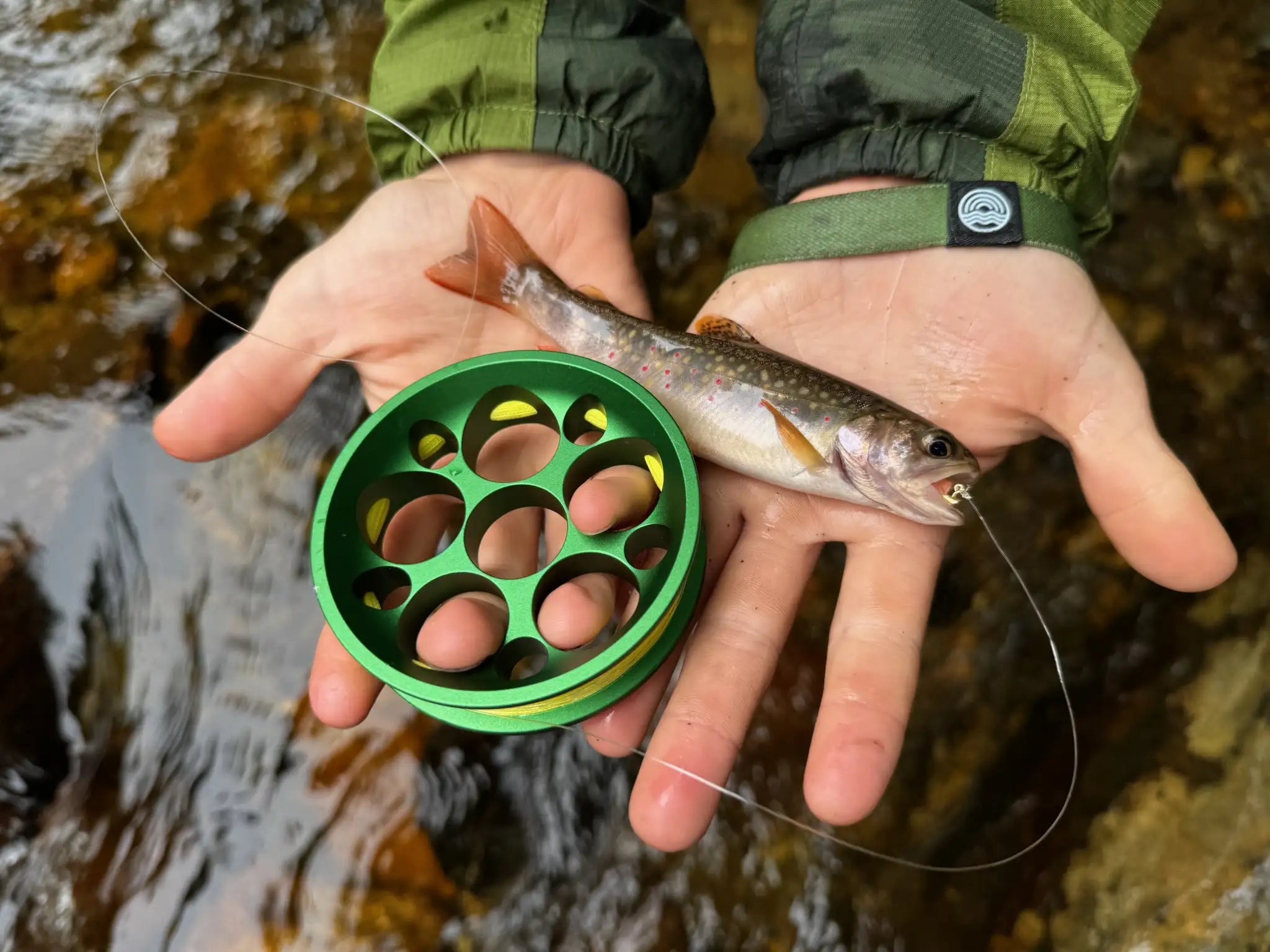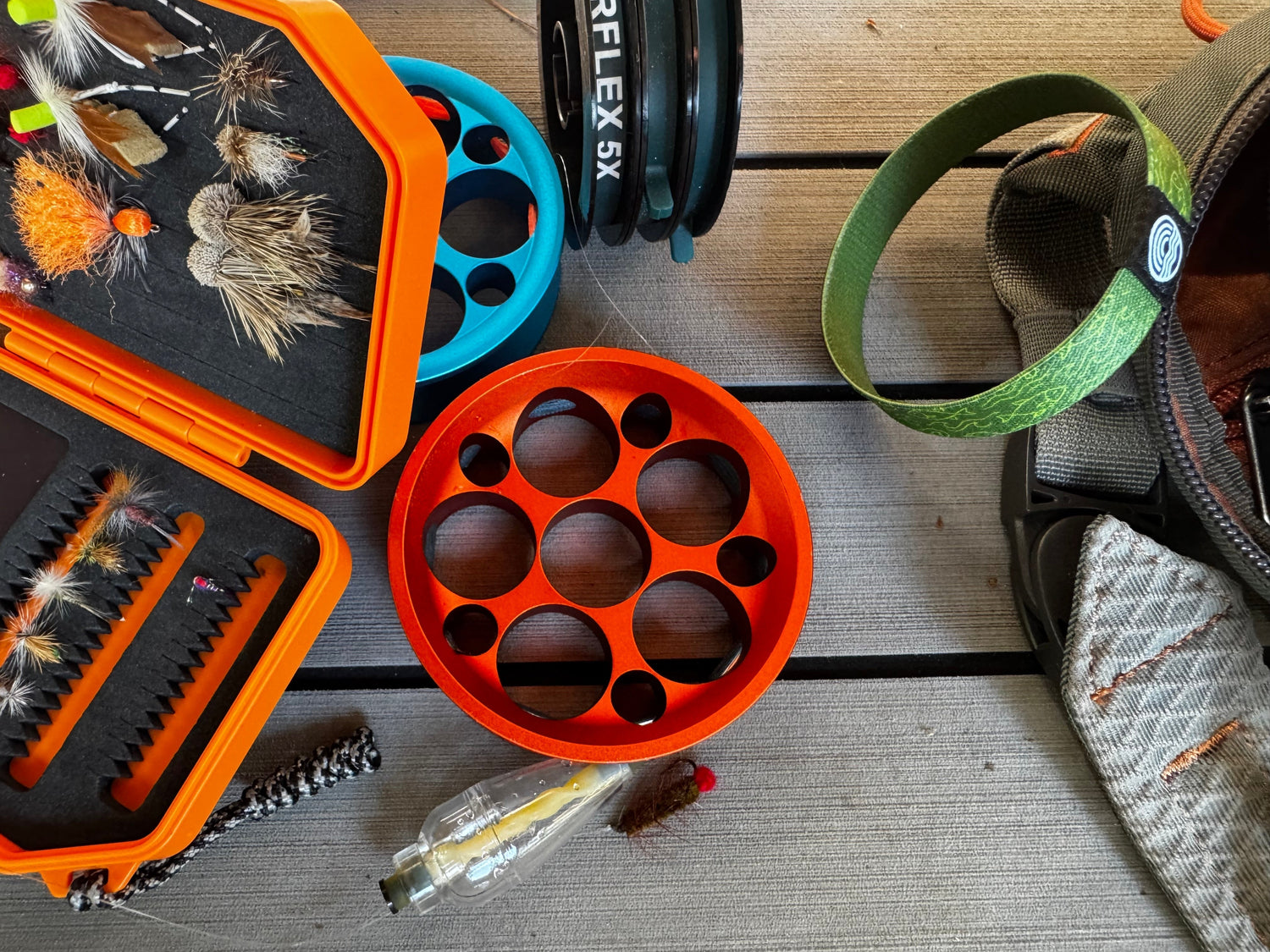The Only Native: Southern Appalachian Brook Trout (Salvelinus fontinalis)

The Genetics Tell the Story
Recent genetic studies reveal that Western North Carolina's brook trout represent a unique strain called Southern Appalachian brook trout, distinct from their northern cousins. These fish are genetic descendants of Arctic char that once swam in the Gulf of Mexico, making an epic 2,000-mile journey up the Mississippi, Ohio, Tennessee, and French Broad rivers to reach the mouths of our mountain streams.
Think about that adventure – roughly the distance from North Carolina to Alaska. These brook trout have been resident in the Blue Ridge for around 1.6 million years, making them possibly the oldest vertebrate animal species in the mountains alongside salamanders.
Local Names: Specks, speckled trout, brookies, natives, squaretails Scientific Classification: Salvelinus fontinalis (Southern Appalachian strain) Status: North Carolina's official state freshwater trout (designated in 2005)
Identification: Recognizing a True Native
Southern Appalachian brook trout are easy to identify once you know what to look for. They're not actually trout at all – they're char, belonging to the genus Salvelinus. This distinction shows in their coloration and markings.
Physical Characteristics:
- Size: Generally 6-8 inches in wild populations, rarely exceeding 10 inches
- Weight: Typically 1/4 to 1/2 pound
- Lifespan: Short-lived, seldom longer than 4 years in the wild
- Body shape: Streamlined with a slightly compressed body
Distinctive Markings:
- Back and sides: Olive-green to dark green coloration with distinctive "worm-like" vermiculations (wavy patterns) extending from the back onto the dorsal fin
- Spotting: Yellow spots interspersed with bright red spots surrounded by sky-blue halos
- Belly: Bright orange-red, especially during spawning season
- Fins: Orange to red lower fins with distinctive white leading edge bordered by black – this white-bordered edge is a dead giveaway for char species
- Tail: Dark with minimal spotting, unlike rainbow trout
The Spawning Colors: During fall spawning season (September-November), male brook trout develop intense colors – their bellies turn as orange as maple leaves, making them absolutely stunning.
How to Distinguish From Non-Natives
When you're hand reel fishing in WNC waters, you'll likely encounter all three species. Here's how to tell them apart:
vs. Rainbow Trout (Oncorhynchus mykiss):

- Rainbows have a distinctive pink-red stripe along their sides
- Heavy black spotting on the tail (brook trout have minimal tail spots)
- More silvery overall coloration
- No white-edged fins
- Generally larger and more robust
vs. Brown Trout (Salmo trutta):

- Browns have golden-brown coloration with large dark spots
- Orange or reddish spots, sometimes with light halos
- No distinctive fin coloration
- Typically inhabit lower, warmer sections of streams
- Often grow much larger than brook trout
Quick ID Test: Look for the white-edged fins with black borders – if you see this, you've got a char (brook trout). No other trout species in WNC has this marking.
Habitat and Behavior: Where to Find Native Brook Trout
The Cold Water Requirement

Southern Appalachian brook trout are the ultimate cold-water specialists. They require exceptionally clean, cold water rich in oxygen – typically found only in high-altitude headwater streams. Water temperatures above 68°F become stressful, and anything over 75°F can be lethal.
Prime Habitat Characteristics:
- Elevation: Generally above 3,000 feet, though some populations exist lower
- Water temperature: Preferably below 65°F, never above 70°F for extended periods
- Water quality: Pristine conditions with high dissolved oxygen
- Cover: Deep pools, undercut banks, large rocks, fallen logs
- Substrate: Clean gravel and cobble for spawning
Where Hand Reel Fishing Shines

The best native brook trout habitat is often inaccessible to traditional tackle. These fish thrive in:
- Tiny headwater streams – sometimes just 3-4 feet wide
- Steep gradient waters with pocket pools and cascades
- Remote locations requiring significant hiking
- Heavily vegetated areas with overhanging rhododendron and hemlock
This is where your GoReel Pro becomes invaluable. While other anglers struggle with rod management in tight quarters, you're fishing effectively in spaces barely wider than your arm span.
Daily and Seasonal Patterns
Daily Activity:
- Most active: Dawn and dusk (crepuscular behavior)
- Midday: Often retreat to deeper water or heavy cover
- Feeding behavior: Opportunistic, but more cautious than stocked trout
Seasonal Behavior:
- Spring: Active feeding as water warms, insects become available
- Summer: Seek thermal refugia in coldest available water
- Fall: Spawning behavior (September-November), brilliant colors
- Winter: Slower metabolism, less active but still feeding
Feeding Habits and Diet
Native brook trout are opportunistic predators with a varied diet that changes seasonally and by availability:
Primary Food Sources:
- Aquatic insects: Mayflies, caddisflies, stoneflies, midges
- Terrestrial insects: Ants, beetles, grasshoppers, caterpillars
- Other prey: Small crayfish, salamanders, occasionally small fish
- Seasonal specialties: Flying ants in summer, terrestrials in fall
Hand Reel Advantages: The direct connection of hand reel fishing lets you feel the subtle takes that are characteristic of wild brook trout. These fish are more cautious than their stocked cousins but also more curious – they'll investigate a well-presented fly longer than hatchery fish.
Hand Reel Strategies for Native Brook Trout

Tackle Recommendations
Primary Setup:
- GoReel River Kit for typical mountain streams
Line and Leader:
- Light tippet (6X-7X) for spooky wild fish
- LineLocks for quick adjustments between pools
- Shorter leaders in tight quarters (3-4 feet maximum)
Techniques for Native Waters
The Stealth Approach: Native brook trout are incredibly wary. In the clear, shallow waters they inhabit, your approach matters more than your fly selection. Hand reel fishing's low profile gives you a significant advantage.
- Stay low and move slowly
- Fish from downstream, moving up
- Use natural cover – rocks, trees, bushes
- Minimize false casting – hand reels let you make direct presentations
Effective Hand Reel Techniques:
- Gentle Underhand Toss: Perfect for delicate presentations in small pools
- Sidearm Cast: Works around overhanging vegetation
- Direct Drop: Ideal for fishing deep plunge pools below small waterfalls
- Bow-and-Arrow Cast: Essential technique for extremely tight quarters
Pro Tip from Crystal Creek Gear team: "Native brook trout waters demand stealth and precision. Your hand reel's compact nature lets you fish spots that others simply can't reach effectively." - Mike McKearin
Seasonal Strategies
Spring (March-May):
- Focus on emerging insects – small nymphs and dry flies
- Fish slower, deeper pools as water temperatures are still cold
- Early season can be exceptional as fish haven't seen much fishing pressure
Summer (June-August):
- Terrestrial insects become important – ants, beetles, small hoppers
- Fish thermal refugia – springs, deep pools, shaded areas
- Best fishing during cooler parts of the day
Fall (September-November):
- Spawning season brings brilliant colors and aggressive behavior
- Use slightly larger flies to match increased metabolism
- Be extra careful around redds (spawning beds) – observe but don't disturb
Winter (December-February):
- Slow presentations with small nymphs and streamers
- Focus on the deepest, slowest water available
- Midday fishing can be productive when temperatures moderate
Conservation: Protecting WNC's Native Heritage
The Challenges Facing Native Brook Trout
Since 1900, brook trout range has declined by about 80 percent. The challenges are real and ongoing:
Historical Impacts:
- Logging operations in the late 1800s devastated stream habitats
- Introduction of non-native species created competition for food and spawning sites
- Genetic dilution from stocking of northern strain brook trout
Current Threats:
- Climate change – rising water temperatures
- Development pressure in mountain watersheds
- Acid rain from air pollution
- Sedimentation from erosion and development
How Hand Reel Anglers Can Help
Practice Catch and Release: Native brook trout populations are fragile. Every fish returned to the water helps maintain these unique genetic lines. The direct contact of hand reel fishing actually improves release survival rates compared to traditional tackle.
Support Habitat Protection:
- Maintain vegetated stream buffers on private land
- Support organizations working on brook trout conservation
- Follow Leave No Trace principles in native waters
Spread Awareness: Understanding the difference between native and non-native trout helps with conservation efforts. Share your knowledge with other anglers.
Choose Your Waters Wisely: Focus harvest pressure on stocked waters and delayed harvest sections. Treat native brook trout waters as special places deserving extra care.
Where to Find Native Brook Trout in WNC
General Guidelines
Native populations persist primarily in:
- High-elevation headwaters (above 3,000 feet)
- Streams above natural barriers (waterfalls, cascades)
- Remote areas with minimal development pressure
- Spring-fed tributaries with year-round cold water
Specific Regions
While specific stream locations aren't shared to protect these fragile populations, native brook trout can be found in:
- Great Smoky Mountains National Park
- Pisgah National Forest headwater streams
- Nantahala National Forest high-elevation waters
- Blue Ridge Parkway area tributaries
- Private mountain streams with good habitat
Research Tip: Use the NC Wildlife Resources Commission's Public Mountain Trout Waters map to identify potential native waters, then look for the highest, most remote tributaries.
The Hand Reel Advantage in Native Waters
Why Minimalist Tackle Works

Native brook trout habitat demands a different approach than stocked waters. Traditional tackle often fails in these environments because:
- Access is difficult: Long hikes, steep terrain, dense vegetation
- Streams are small: Often too narrow for conventional casting
- Fish are spooky: Heavy tackle and commotion spook these wild fish
- Precision matters: Exact presentations in small pockets
The Perfect Match
Hand reel fishing and native brook trout fishing are perfectly matched:
Portability: Your GoReel weighs less than most individual flies boxes, making long hikes to remote waters feasible
Stealth: No rod flash, minimal movement, quiet presentations
Precision: Direct control over line placement in tiny pockets
Versatility: Quick transitions between techniques as stream conditions change
Durability: No delicate rod tips to break on overhanging branches
A Different Kind of Adventure
Fishing for native brook trout isn't about numbers or size – it's about connection. You're fishing for a species that predates human presence in North America, in waters that remain largely unchanged since the last ice age. Every native "speck" is a link to the deep history of these ancient mountains.
With your hand reel gear, you can access this history. You can fish the tiny headwaters where logging never reached, where these beautiful char still flash their orange bellies in fall-colored pools. It's fishing distilled to its essence – you, the water, and a species that has survived ice ages and human expansion.
The Bottom Line: Respect the Native
Southern Appalachian brook trout represent something irreplaceable – a direct genetic link to the pre-colonial ecosystem of these mountains. They're not just fish; they're living indicators of watershed health and fragments of biological history.
When you encounter one of these beautiful char in a remote WNC headwater, take a moment to appreciate what you're seeing. That orange-bellied "speck" represents over a million years of adaptation to these specific waters. Its genetic code carries information about ice ages, ancient migrations, and the resilience of life itself.
Your hand reel fishing approach respects this heritage. The light touch, minimal impact, and stealth tactics align perfectly with conservation principles. You're not just fishing – you're participating in a story that stretches back to the retreat of continental glaciers.
Ready to explore WNC's native trout waters? Start with our GoReel Pro and discover fishing that connects you to the deep history of the Southern Appalachians.





